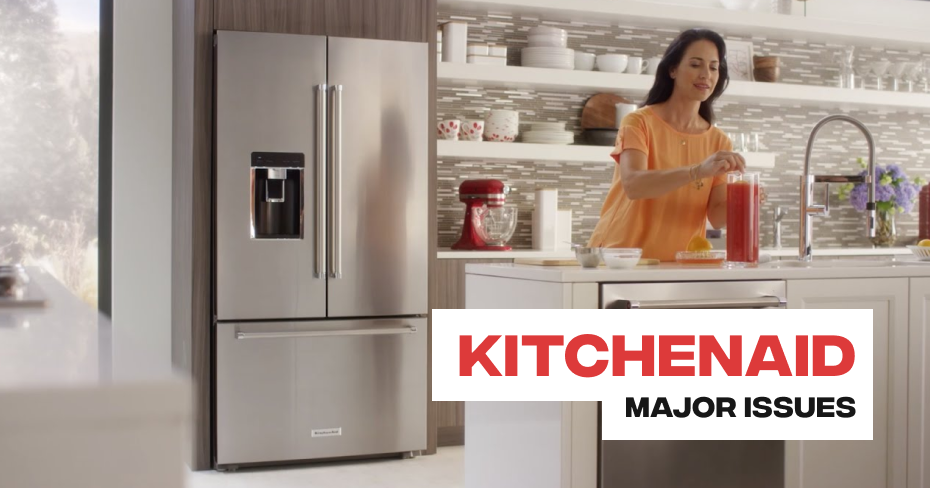
Kitchenaid Refrigerator Freezer Not Freezing
Is the refrigerator located in a garage?
This refrigerator is designed for indoor, household use only. It is intended for use in a location where the temperature ranges from a minimum of 55°F (13°C) to a maximum of 110°F (43°C). Operating the refrigerator outside of the recommended temperature range may result in improper temperatures, temperature fluctuation, and/or the refrigerator to not running at peak performance.
Did the power recently go out?
The Power Outage indicator (on some models) lets you know if the power supply to the refrigerator has been off and the freezer temperature has risen.
The control panel display will read “Power Outage” and an alert tone will sound 3 times. Touch any button to stop the tone, and touch any button again to turn off the Power Outage icon. Once the power outage has been confirmed, “Power Outage” icon will disappear and the display will return to the Home screen.
Do the condenser coils need to be cleaned?
There is typically no need for routine condenser cleaning in a normal home operating environment. However, if the environment is particularly greasy or dusty, or there is significant pet traffic in the home, the condenser should be cleaned every 2 to 3 months to ensure maximum efficiency. Refer to the Owner’s Manual for additional information on cleaning the condensers for your specific refrigerator model. Some models do not require the condenser coils to be cleaned and other models can only be cleaned by a certified technician.
Is the cooling function turned On?
If the refrigerator is not cooling properly, check to make sure the Refrigerator is turned on. Some Refrigerators need to be manually turned back on after a power outage or power surge. The Refrigerator could also accidentally be turned off during routine cleaning.
For Information on how to turn the Refrigerator Off and On, please see your Owner’s Manual for specific information on your model.
Are the controls set correctly for the surrounding conditions?
Temperature controls are preset at the factory to the “mid setting” which should be correct for normal household use. The controls are set correctly when beverages are as cold as you would like.
- If you need to adjust the temperature, wait at least 24 hours between adjustments and then recheck the temperature.
- To make the Refrigerator colder, adjust the control to the next higher setting. To make the Refrigerator less cold, adjust the control to the next lower setting.
- Repeat this process until the desired temperature is reached
Is the refrigerator located next to a heat source?
It is recommended that you do not install the refrigerator near an oven, radiator, or another heat source. Doing may cause the refrigerator to not cool properly. For best performance, do not install the refrigerator behind a cabinet door or block the base grille.
Is the refrigerator in the “showroom” or “demo” mode?
This mode (on some models) is used only when the refrigerator is on display in a retail store. The interior lights will turn on but the refrigerator and freezer sections will not cool.
If you unintentionally turn on Showroom mode, the word “Showroom” will light up on the display (on some models). The sequence for exiting showroom mode varies by model, so please refer to your Owner’s Manual.
Was the refrigerator recently Installed?
If the refrigerator was recently installed check the following items:
- Allow 24 hours for the freezer to reach proper temperatures
- Check to make sure the freezer door is sealing properly; removing any missed packaging material or rearranging bins are needed
Are the air vents blocked?
In order to ensure proper temperature, you need to allow room for proper airflow between the freezer and refrigerator compartments. Cool air enters and exits the refrigerator compartment from the freezer compartment through vents. Depending on your model, these vents are in different locations.
- Locate the vents in both the freezer and refrigerator compartments and ensure that there is nothing blocking the airflow.
- If vents are blocked, airflow will decrease. Temperature and moisture issues may arise due to blocked vents.
- Items placed directly in the airflow from the freezer compartment to the refrigerator compartment may freeze. Do not place temperature-sensitive items, such as eggs and liquids, in these areas.
Has a large amount of food or beverages been added to the refrigerator?
Adding a large amount of food or beverages warms the refrigerator or freezer. It can take several hours for the refrigerator temperature to stabilize after adding a large number of warm items.
Is the room temperature hotter than normal?
The motor will run longer under warm conditions. At normal room temperatures, your motor will run about 40% to 80% of the time. Under warmer conditions, expect it to run even more of the time. Do not install in a location where the temperature will fall below 55°F (13°C).
Has the door been opened often?
- Try to get everything you need out of the refrigerator at once, keep food organized so it is easy to find, and close the refrigerator as soon as the food is removed.
- Be aware the refrigerator will warm when the door is opened often and for long periods of time
- Opening the door often also allows excess moisture into the refrigerator, potentially creating frost or condensation